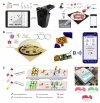Smartphone-Based Multiplexed Biosensing Tools for Health Monitoring
- PMID: 36004979
- PMCID: PMC9406027
- DOI: 10.3390/bios12080583
Smartphone-Based Multiplexed Biosensing Tools for Health Monitoring
Abstract
Many emerging technologies have the potential to improve health care by providing more personalized approaches or early diagnostic methods. In this review, we cover smartphone-based multiplexed sensors as affordable and portable sensing platforms for point-of-care devices. Multiplexing has been gaining attention recently for clinical diagnosis considering certain diseases require analysis of complex biological networks instead of single-marker analysis. Smartphones offer tremendous possibilities for on-site detection analysis due to their portability, high accessibility, fast sample processing, and robust imaging capabilities. Straightforward digital analysis and convenient user interfaces support networked health care systems and individualized health monitoring. Detailed biomarker profiling provides fast and accurate analysis for disease diagnosis for limited sample volume collection. Here, multiplexed smartphone-based assays with optical and electrochemical components are covered. Possible wireless or wired communication actuators and portable and wearable sensing integration for various sensing applications are discussed. The crucial features and the weaknesses of these devices are critically evaluated.
Keywords: biomarkers; biosensors; clinical diagnosis; electrochemical sensor; multiplexed detection; point-of-care (PoC) testing; smartphone-based detection.
Conflict of interest statement
The authors declare no conflict of interest.
Figures





Similar articles
-
Recent advancements of smartphone-based sensing technology for diagnosis, food safety analysis, and environmental monitoring.Talanta. 2024 Aug 1;275:126080. doi: 10.1016/j.talanta.2024.126080. Epub 2024 Apr 10. Talanta. 2024. PMID: 38615454 Review.
-
Smartphone-based mobile biosensors for the point-of-care testing of human metabolites.Mater Today Bio. 2022 Apr 8;14:100254. doi: 10.1016/j.mtbio.2022.100254. eCollection 2022 Mar. Mater Today Bio. 2022. PMID: 35469257 Free PMC article. Review.
-
Biosensors and bioelectronics on smartphone for portable biochemical detection.Biosens Bioelectron. 2016 Jan 15;75:273-84. doi: 10.1016/j.bios.2015.08.037. Epub 2015 Aug 20. Biosens Bioelectron. 2016. PMID: 26319170 Review.
-
Additively manufactured multiplexed electrochemical device (AMMED) for portable sample-to-answer detection.Lab Chip. 2023 Dec 5;23(24):5107-5119. doi: 10.1039/d3lc00314k. Lab Chip. 2023. PMID: 37921001
-
Smartphone based aptasensors as intelligent biodevice for food contamination detection in food and soil samples: Recent advances.Talanta. 2023 Jan 15;252:123769. doi: 10.1016/j.talanta.2022.123769. Epub 2022 Aug 14. Talanta. 2023. PMID: 36041314 Review.
Cited by
-
AI-Assisted Detection of Biomarkers by Sensors and Biosensors for Early Diagnosis and Monitoring.Biosensors (Basel). 2024 Jul 22;14(7):356. doi: 10.3390/bios14070356. Biosensors (Basel). 2024. PMID: 39056632 Free PMC article. Review.
-
Lateral Flow Assay: A Summary of Recent Progress for Improving Assay Performance.Biosensors (Basel). 2023 Aug 23;13(9):837. doi: 10.3390/bios13090837. Biosensors (Basel). 2023. PMID: 37754072 Free PMC article. Review.
-
Maximising the translation potential of electrochemical biosensors.Chem Commun (Camb). 2025 Aug 28;61(71):13359-13377. doi: 10.1039/d5cc02322j. Chem Commun (Camb). 2025. PMID: 40814868 Free PMC article. Review.
-
Negative Pressure Smart Patch to Sense and Heal the Wound.Adv Sci (Weinh). 2025 Jan;12(3):e2408077. doi: 10.1002/advs.202408077. Epub 2024 Nov 28. Adv Sci (Weinh). 2025. PMID: 39605188 Free PMC article.
-
Advanced visual sensing techniques for on-site detection of pesticide residue in water environments.Heliyon. 2023 Feb 24;9(3):e13986. doi: 10.1016/j.heliyon.2023.e13986. eCollection 2023 Mar. Heliyon. 2023. PMID: 36915503 Free PMC article. Review.
References
Publication types
MeSH terms
Substances
LinkOut - more resources
Full Text Sources

